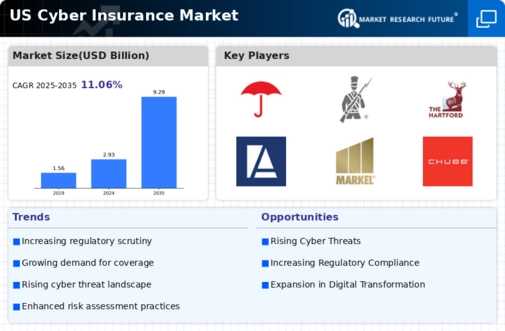The US Cyber Insurance Market has witnessed significant growth over the past few years, driven by the increasing frequency and sophistication of cyber threats facing businesses and individuals alike. As organizations become more reliant on digital infrastructure, the need for cyber insurance to protect against potential financial losses from data breaches, ransomware, and other cyber incidents has never been more critical. The competitive landscape of this market is characterized by a diverse range of players, each vying to establish a strong presence and offer tailored products that meet the unique risk profiles of different sectors.
Insurers are increasingly focusing on enhancing their underwriting capabilities, leveraging advanced data analytics and predictive modeling to provide comprehensive coverage options that cater to the evolving landscape of cyber risks. The competition is intensifying, with companies continuously innovating and adapting their policies to address the multifaceted challenges posed by cyber threats.
Travelers has emerged as a formidable force within the US Cyber Insurance Market, capitalizing on its extensive industry expertise and strong distribution network. With a robust portfolio of cyber insurance offerings, Travelers caters to a wide variety of clients, ranging from small businesses to large corporations. Their strength lies in a deep understanding of the risks associated with various industries, enabling them to develop customized policies that mitigate potential financial impact stemming from cyber incidents. Travelers also benefits from a strong financial rating, which provides reassurance to clients regarding their ability to handle claims.
The company's proactive approach to risk management includes providing valuable resources, such as cybersecurity assessments and employee training programs, which bolster their reputation as a trusted partner in navigating the complexities of cyber insurance.
Berkshire Hathaway has made notable strides in the US Cyber Insurance Market, showcasing its commitment to addressing the growing demand for cyber risk mitigation solutions. This company offers a range of key products and services specifically designed to combat cyber threats, including data breach coverage, business interruption insurance, and liability protection for businesses facing cyber-attacks. Berkshire Hathaway's strong market presence is reinforced by its financial stability and the backing of its extensive investment portfolio. The company has developed a reputation for its conservative underwriting practices and comprehensive claims support, positioning it well within the competitive landscape.
Recent mergers and acquisitions have allowed Berkshire Hathaway to augment its cyber insurance capabilities, expanding its service offerings while enhancing its technological prowess to better assess and manage risks associated with cyber incidents. This strategic positioning allows Berkshire Hathaway to maintain a competitive edge in a rapidly evolving market, demonstrating resilience and adaptability in the face of ever-increasing cyber threats.














